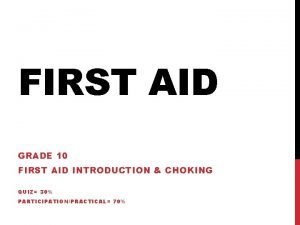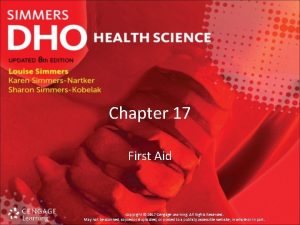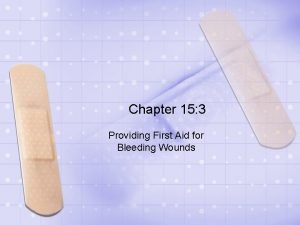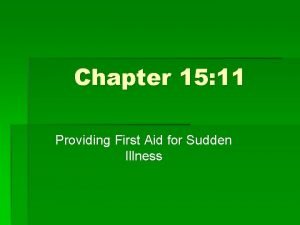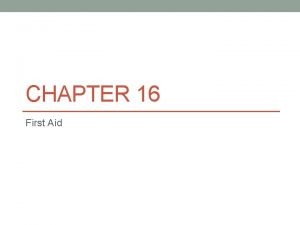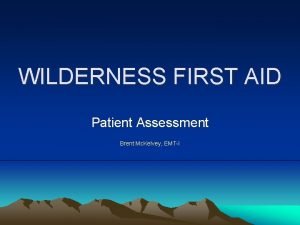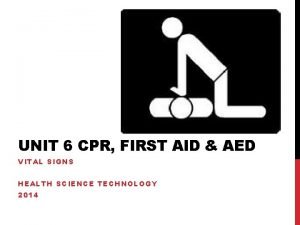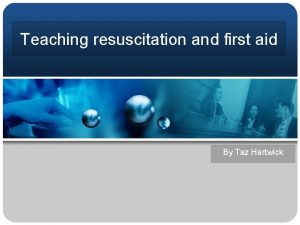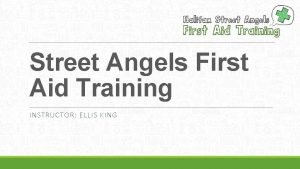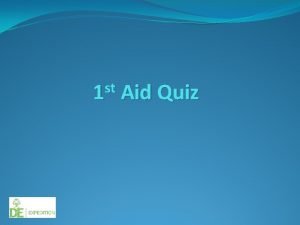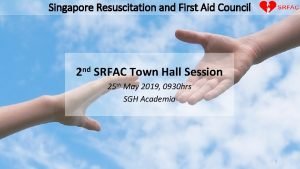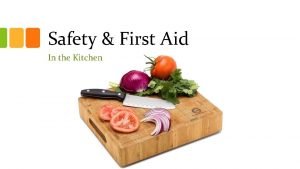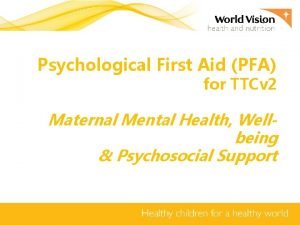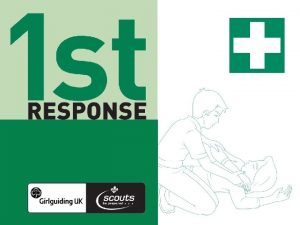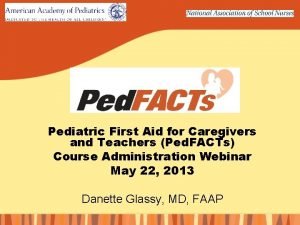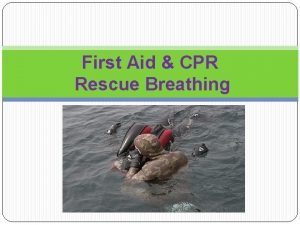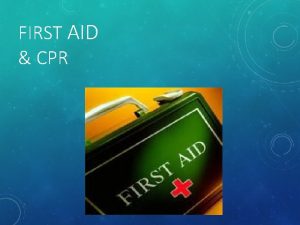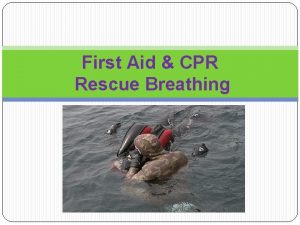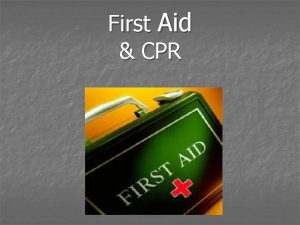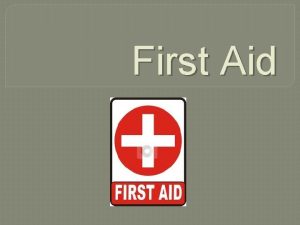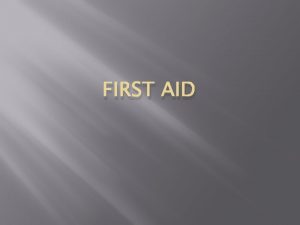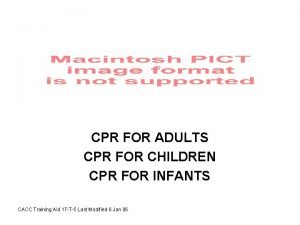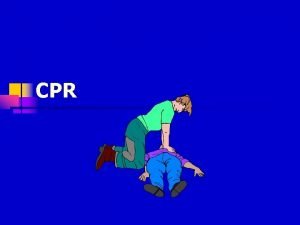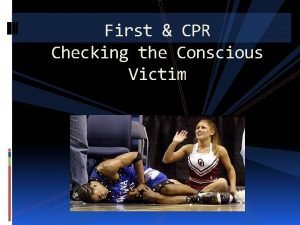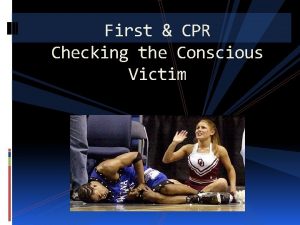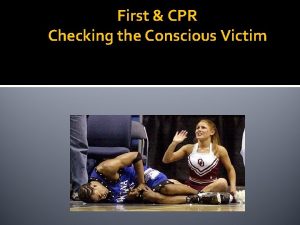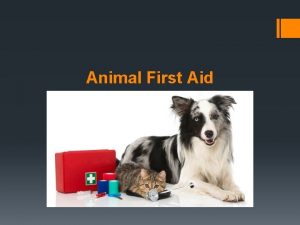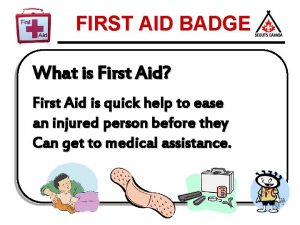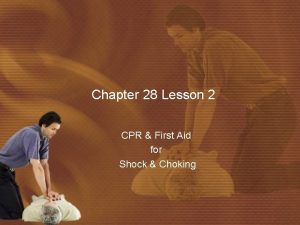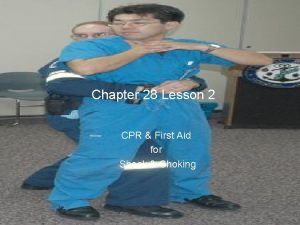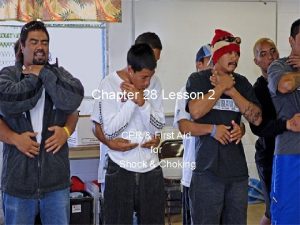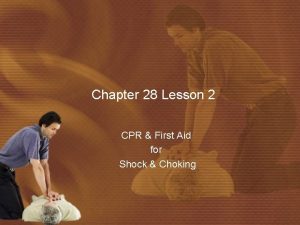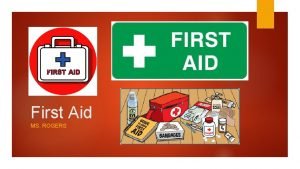Chapter 28 Lesson 2 CPR First Aid for























- Slides: 23

Chapter 28 Lesson 2 CPR & First Aid for Shock & Choking

You’ll learn to… • Identify the appropriate steps for responding to life-threatening emergencies. • Analyze strategies for responding to an emergency situation requiring CPR. • Analyze strategies for responding to a shock or choking victim.

Life-Threatening Emergencies • If a victim in an emergency is unresponsive, you must begin immediately the chain of survival, a sequence of actions that maximize • First two-links: call 9 -1 -1 & begin CPR • Next two-links: early defibrillation & transfer to advanced care (usually the responsibility of the emergency medical personnel when they arrive)

Life-Threatening Emergencies continued… • Defibrillator-is a device that delivers an electrical shock to the heart to restore its normal rhythm. • An automated external defibrillator (AED) is a handheld device that you can be trained to use.

CPR • A person whose breathing & heartbeat have stopped may need CPR. • Cardiopulmonary Resuscitation- is a lifesaving first-aid procedure that combines rescue breaths with chest compressions, supplying oxygen to the body until normal body functions can resume. • You must be properly trained by a professional and certified before administering CPR.

CPR for Adults • The steps of CPR are known as the ABCs. A- airway, B- Breathing, & C- circulation • If a person is unresponsive, tap him/her on the shoulder & ask in a loud voice, “Are you okay? ” • If the victim does not respond, call 9 -1 -1 or have someone else call. • Then kneel beside the victim & follow these steps…

CPR for Adult continued… • Airway- look inside victim’s mouth, remove anything that you see blocking the airway. • Open the airway- gently tilt the head back by lifting the chin with one hand while pushing down on the forehead with the other.

CPR for Adult continued… • Breathing- Look, listen & feel for breathing. – Look for chest movement – Listen at victim’s mouth for breathing – Feel for exhaled air on your cheek, if victim is not breathing normally, begin rescue breathing

Rescue Breathing… – rescue breathing… 1. Keeping the victim’s head in the proper position, pinch nostrils shut. 2. Place your mouth over the victim’s mouth forming a seal. Give 2 slow breaths, each for about 2 seconds long. The victim’s chest should rise with each breath.

CPR for Adult continued… • Circulation- check for signs of circulation, such as breathing, coughing, or movement. If there are no signs of circulation, a person trained in CPR should begin chest compressions immediately. If the victim responds but is still not breathing normally, give 1 rescue breath every 5 seconds.

CPR for Adult continued… Perform chest compressions: Place the heel of one hand on the breastbone right between the nipples. Place the heel of your other hand on top of the first hand. Position your body directly over your hands. Your shoulders should be in line with your hands. DO NOT lean back or forward. As you gaze down, you should be looking directly down on your hands. Give 15 chest compressions. Each time, press down about 2 inches into the chest. These compressions should be FAST with no pausing. Count the 15 compressions quickly:

CPR for Adult continued… Give the person 2 slow, full breaths. The chest should rise. Continue cycles of 15 chest compressions followed by 2 slow, full breaths. After about 1 minute (four cycles of 15 compressions and 2 breaths), re-check for signs of circulation. Repeat steps until the person recovers or help arrives. If the person starts breathing again, place him or her in the recovery position. Periodically re-check for breathing and signs of circulation until help arrives.

CPR for Infants & Children • The ABC’s are the same for infant and children as checking an adult • Click on link below: • Infant Child CPR Instructions

First Aid for Shock • When something happens to reduce blood flow throughout the body, limiting the amount of oxygen carried to the cells, shock may occur. • Shock is a failure of the cardiovascular system to keep an adequate supply of blood circulating to the vital organs of the body. • It requires immediate medical attention.

Signals of Shock • • • Restlessness / irritability Altered consciousness Nausea Pale, cool, moist skin Rapid breathing Rapid pulse

Caring for Shock • Have victim lie down, elevate legs about 12” (unless you suspect head, neck, back injuries) • Call 9 -1 -1 • Control any external bleeding • Help victim maintain body temperature • Do not give food or drink, may cause vomiting • Reassure victim


First Aid for Choking • Choking occurs when a person’s airway becomes blocked. • If obstruction is not removed, the victim can die from lack of oxygen within a few minutes. • Signs of choking: – Person may clutch throat (universal sign) – May cough weakly – Make high pitched noises – May turn blue in the face

First Aid for Choking continued… • If you suspect someone is choking, “Ask you choking? ” and look for universal choking sign. • Then ask, “Can you speak? ” • If the person cannot speak, the airway is completely blocked & the victim need first aid. • Stand behind victim an give abdominal thrusts.

Abdominal Thrusts • Place thumb side of fist against middle of abdomen, just above navel. • Grasp fist with other hand • Give quick inward / upward thrusts • Repeat until object is coughed up or unconscious

Infant choking • Click on link below • http: //www. youtube. com/watch? v=f 5 FFBSh 366 E

Chapter 28 Lesson 2 Review Questions 1. Define cardiopulmonary resuscitation. 2. Why should you never give a shock victim anything to eat or drink? 3. What is the universal sign for choking? 4. Explain why is important to check the airway before beginning CPR. 5. Compare the strategy for responding to a choking adult with the strategy for responding to a choking infant.

Chapter 28 Lesson 2 Review Questions continued… 6. The first link in the chain of survival is to… a. Begin CPR c. phone 911 b. Begin defibrillation d. going to the hospital 7. Restlessness, skin that is pale, cool, and moist, and rapid breathing and pulse are all symptoms of a. Choking c. concussion b. Shock d. unconsciousness 8. When performing CPR on an infant, place your mouth over the infant’s mouth and pinch the nostrils shut. (true or false) 9. You should not administer back blows & abdominal thrust to a person who seems to be choking but can still speak. (true or false) 10. Because an unconscious person cannot cough or clear the airway, he or she is at risk of choking. (true or false)
 First aid merit badge first aid kit
First aid merit badge first aid kit What are the objectives of first aid?
What are the objectives of first aid? Chapter 17:7 providing first aid for heat exposure
Chapter 17:7 providing first aid for heat exposure 17:4 providing first aid for shock
17:4 providing first aid for shock 16:3 providing first aid for bleeding and wounds
16:3 providing first aid for bleeding and wounds Providing first aid for sudden illness
Providing first aid for sudden illness Chapter 8 emergency care first aid and disasters
Chapter 8 emergency care first aid and disasters Chapter 28 first aid and emergencies
Chapter 28 first aid and emergencies Chapter 16:1 providing first aid
Chapter 16:1 providing first aid Neasden and greenhill medical centre
Neasden and greenhill medical centre Wilderness first aid patient assessment form
Wilderness first aid patient assessment form Air cadet first aid badge
Air cadet first aid badge Vital signs cpr
Vital signs cpr Unit 15:10 providing first aid for specific injuries
Unit 15:10 providing first aid for specific injuries Coyne first aid
Coyne first aid Chample first aid
Chample first aid Three ps in first aid
Three ps in first aid First aid quiz for students
First aid quiz for students Bcls singapore pdf
Bcls singapore pdf First aid in the kitchen
First aid in the kitchen Camping merit badge powerpoint
Camping merit badge powerpoint Psychological first aid
Psychological first aid Preserve life first aid
Preserve life first aid Pediatric first aid for teachers
Pediatric first aid for teachers

